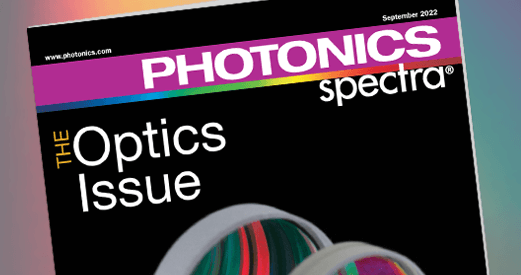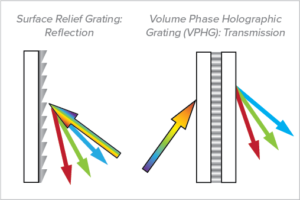 Trends toward smaller spectrometers are pushing the boundaries of conventional diffraction gratings for increased performance. In this Photonics Spectra article, Advancements in Diffraction Gratings Aim to Change the Rules, Contributing Editor, Hank Hogan, discusses the role diffraction gratings have played in enabling the increasing trend towards smaller spectrometers, which calls for new dispersive elements with denser lines and more sophisticated designs than many conventional diffraction gratings have traditionally offered. As Hogan states, diffraction gratings “lie at the heart of modern spectrometers, hyperspectral imagers, optical coherence tomography systems…” and thus, emerging smaller spectrometers are causing designers and gratings manufacturers to address performance challenges and geometric limits of conventional gratings.
Trends toward smaller spectrometers are pushing the boundaries of conventional diffraction gratings for increased performance. In this Photonics Spectra article, Advancements in Diffraction Gratings Aim to Change the Rules, Contributing Editor, Hank Hogan, discusses the role diffraction gratings have played in enabling the increasing trend towards smaller spectrometers, which calls for new dispersive elements with denser lines and more sophisticated designs than many conventional diffraction gratings have traditionally offered. As Hogan states, diffraction gratings “lie at the heart of modern spectrometers, hyperspectral imagers, optical coherence tomography systems…” and thus, emerging smaller spectrometers are causing designers and gratings manufacturers to address performance challenges and geometric limits of conventional gratings.
The article begins with a short history of how gratings are used to separate light and then details the different types of diffraction gratings and the different manufacturing processes used by the leading gratings manufacturers, including Wasatch Photonics. A distinction is made, by Hogan, between the conventional reflection or surface relief gratings, which have ruled lines or groves on the surface vs. Volume Phase Holographic (VPH) transmission  gratings, which we offer. Our unique, proprietary, and patented design technologies surmount many of the drawbacks of conventional reflection gratings by imaging a periodic structure of high and low index of refraction into dichromated gelatin hermetically sealed between two optical windows. While other manufacturers are striving to surpass the typical surface relief ruled gratings with 300, 600, 1200 or 2400 lines per millimeter, we work at UV, VIS, & NIR wavelengths with line frequencies of 150-5000 lines/mm.
gratings, which we offer. Our unique, proprietary, and patented design technologies surmount many of the drawbacks of conventional reflection gratings by imaging a periodic structure of high and low index of refraction into dichromated gelatin hermetically sealed between two optical windows. While other manufacturers are striving to surpass the typical surface relief ruled gratings with 300, 600, 1200 or 2400 lines per millimeter, we work at UV, VIS, & NIR wavelengths with line frequencies of 150-5000 lines/mm.
 Grisms (GRating + prISMs) are highlighted in the article as well, which are compound optical elements comprising a grating and a prism. Offered by few manufacturers beside Wasatch Photonics, grisms are a less commonly used dispersive optic which provides a compact, straight-pass alternative to more complex optical designs. Elroy Pearson, our senior optical engineer, shared a real-life example of the capabilities of one of our grisms for a high-resolution spectrometer, in which our grism provided a line density of 5422 lines/mm to achieve more than 5x the dispersion of a typical instrument over a spectral band measuring less than 5 nm.
Grisms (GRating + prISMs) are highlighted in the article as well, which are compound optical elements comprising a grating and a prism. Offered by few manufacturers beside Wasatch Photonics, grisms are a less commonly used dispersive optic which provides a compact, straight-pass alternative to more complex optical designs. Elroy Pearson, our senior optical engineer, shared a real-life example of the capabilities of one of our grisms for a high-resolution spectrometer, in which our grism provided a line density of 5422 lines/mm to achieve more than 5x the dispersion of a typical instrument over a spectral band measuring less than 5 nm.
Read the full article Advancements in Diffraction Gratings Aim to Change the Rules
 Learn more about VPH Gratings and Grisms:
Learn more about VPH Gratings and Grisms:
September 9, 2022
At Wasatch Photonics, we offer multiple patented design technologies, which gives us more flexibility to recommend the best transmission grating for your unique application. Contact us to discuss your specific needs:


